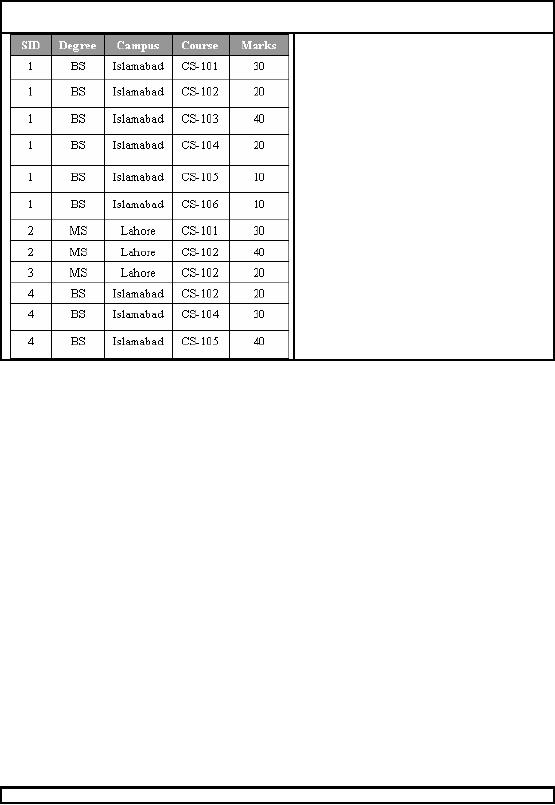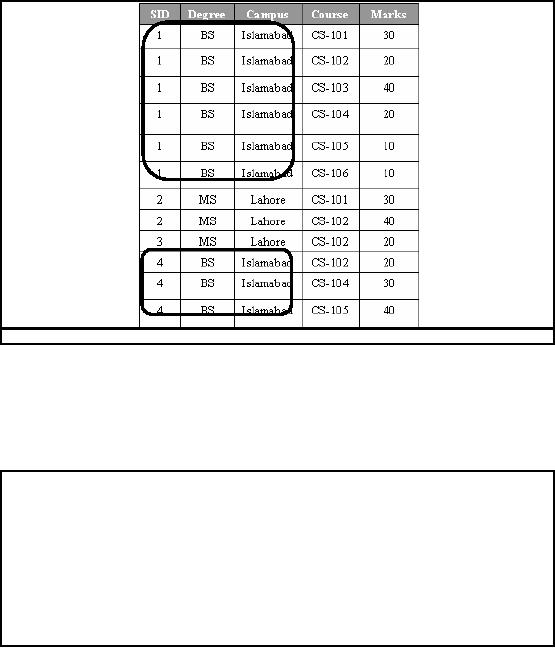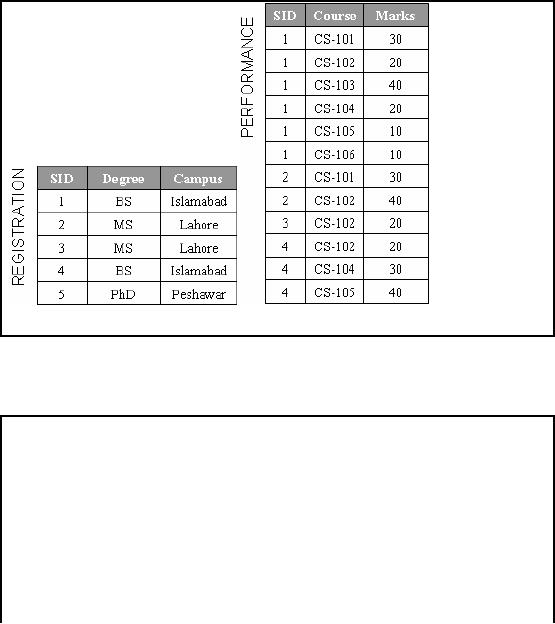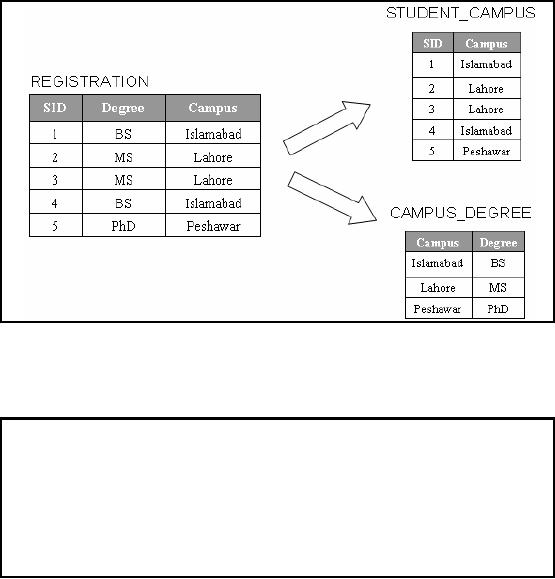 |

Lecture
Handout
Data
Warehousing
Lecture
No. 06
Normalization
Before we begin
our discussion about the
normal forms, it's important to
understand that w hat
we
will
discuss are guidelines and
guidelines only i.e. not a
dejure standard. Sometimes
(especially in
a DSS
environment), it becomes necessary to
drift from this purist
approach to meet
practical
business
requirements of performance. However,
when deviation take place,
it's extremely
important to evaluate
any possible consequences
these deviations would cause
and the
corresponding
inconsistencies and anomalies
this is what de-normalization is
about.
What is
normalization?
What
are the goals of
normalization?
�
Eliminate
redundant data.
�
Ensure
data dependencies make
sense.
What is
the result of normalization?
What
are the levels of
normalization?
Always
follow purist's approach of
normalization?
NO
Normalization is
the process of efficient ly organizing
data in a database by
decomposing
(splitting) a
relational table into smaller
tables by projection. There are
basically two goals
of
normalization as
follows:
1.
Eliminate
redundant data (for example,
storing the same data in more
than one tab
le)
2.
Ensuring
data dependencies make sense
(only storing related data in a
table).
Both of these
are worthy goals, as they
reduce the amount of space a
database consumes,
and
ensure
that data is logically
stored and is in third
normal form (3NF). The
database community
has developed a
series of guidelines or benchmarks
for ensuring that databases
are indeed
normalized.
These goals are referred to
as normal forms and are numbered
from one (the
lowest
form of
normalization, referred to as first
normal form or 1NF) through
five (fifth normal form
or
5NF).
The first two normal forms
are intermediate steps to
achieve the goal of having
all tables in
3NF. Note that
in order to be correct, decomposition
must be lossless i.e. the
new tables can be
recombined by a
natural join to recreate the
original table without
creating any false or
redundant
data
and without any loss of
any data/information.
Consider a
student database system to be developed
for a multi-campus university, such
that it
32

specializes in
one degree program at a
campus i.e. BS, MS or
PhD.
SID:
Student
ID
Degree:
Registered as BS
or MS student
Campus:
City where
campus is located
Course: Course
taken
Marks:
Score
out of max of 50
Figure-6.1:
Part of example student databas e
system
We consider
the case of development of a student
DBMS for a multi-campus
university i.e. with
campuses in
many cities. There is a head
office of the University
(say) in Islamabad which
would
like to
get an overall picture of
all the students at all
the campuses of the university. A
typical
detail table is
shown with a brief description of the
fields. These are in no way
the only fields, but
sufficient to
briefly review the basic
forms of normalization.
In order to
uniquely associate marks
with co urse and the
student, a composite primary
key
composed of
SID and campus is
used.
33

Table
FIRST
Figure-6.2:
Part of example student
database system in
1NF
Although
the table is shown in 1NF
i.e. it contains atomic
values, there are no
repeating values,
there is no
aggregation, yet it contains
redundant data. For example,
information about the
student's
degree, and campus location is
repeated for every course
taken. Redundancy
causes
what are
called update
anomalies. Update
anomalies are problems that
arise when records
are
inserted,
deleted, or updated in the
database. For example, the
following anomalies can
occur:
Normalization:
1NF
Update
Anomalies
INSERT. Certain
student with SID 5 got
admission in a different campus
(say) Karachi cannot be
added
until the student registers
for a course.
DELETE. If
student graduates and
his/her corresponding record is
deleted, then all
information
about
that student is lost.
UPDATE. If
student migrates from
Islamabad campus to Lahore campus
(say) SID = 1, then
six
rows would have
to be updated with this new
information.
INSERT.
The fact that a certain
student with SID 5 got
admission in a different campus
(say)
Karachi cannot
be added until the student
registers for a
course.
DELETE. If
student graduates and
his/her corresponding record is
deleted, then all
information
about
that student is lost.
UPDATE. If
student migrates from
Islamabad campus to Lahore campus
(say) SID = 1, then
six
rows would
have to be updated with this
new information.
34

Normalization:
2NF
Every non-key
column is fully dependent on
the PK.
FIRST is in
1NF but not in 2NF
because degree and campus
are functionally dependent
upon
only on
the column SID of the
composite key (SID, course).
This can be illustrated by listing
the
functional
dependencies in the
table:
SID -->
campus, degree
campus -->
degree
SID and
Campus are NOT
unique
(SID,
Course) --> Marks
To transform the
table FIRST into 2NF we
move the columns SID,
Degree and Campus to a
new
table
called REGISTRATION. The column
SID becomes the primary
key of this new
table.
The
definition of second normal form
states that only tables
with composite primary keys
can be
in 1NF
but not in 2NF.
A relational
table is in second normal form
2NF if it is in 1NF and
every non-key column is
fully
dependent upon
the primary key. That
is, every non-key column
must be dependent upon
the
entire primary
key. The table in the
last slide is in 1NF but
not in 2NF because degree,
course and
even marks
are functionally dependent upon
the SID and the
campus.
FIRST is in
1NF but not in 2NF
because degree and campus
are functionally dependent
upon
only on
the column SID of the
composite key (SID, course).
This can be illustrated by listing
the
functional
dependencies in the
table:
SID -->
campus, status
campus -->
degree
(SID,
Course) --> Marks
35

SID is
now a PK
PERFORMANCE in
2NF as (SID, Course) uniquely
identify Marks
Figure-6.3:
Part of example student
database system in
2NF
To transform the
table FIRST into 2NF we move
the columns SID, Degree
and city to a new
table
called
REGISTRATION. The column SID
becomes the primary key of
this new table.
Normalization:
2NF
Presence of
modification anomalies for
tables in 2NF. For the table
REGISTRATION, they
are:
�
INSERT:
Until a
student gets registered in a
degree program, that program cannot
be
offered!
�
DELETE:
Deleting
any row from REGISTRATION
destroys all other facts in
the table.
Why
there are anomalies?
The
table is in 2NF but NOT in
3NF
Tables in
2NF but not in 3NF
still contain modification
anomalies. In the example
of
REGISTRATION,
they are:
�
INSERT.
The fact that a particular campus
has a certain degree
(Peshawar campus
decides to
run a PhD program) cannot be
inserted until there is a
student registered
for
PhD in the
campus.
�
DELETE. Deleting
any row from REGISTRATION
table destroys the
degree
information
about the campus as well as
the association between
student and campus.
36

Normalization:
3NF
All
columns must be dependent
only on the primary
key.
Table
PERFORMANCE is already in 3NF. The
non-key column, marks, is fully
dependent upon
the
primary key (SID,
degree).
REGISTRATION is
in 2NF but not in 3NF
because it contains a transitive
dependency.
A transitive
dependency occurs when a non-key column
that is a determinant of the
primary key
is the
determinate of other columns.
The
concept of a transitive dependency can be
illustrated by showing the
functional
dependencies:
REGISTRATION.SID
-- >
REGISTRATION.Degree
REGISTRATION.SID
-- >
REGISTRATION.Campus
REGISTRATION.Campus
--> REGISTRATION.Degree
Note that
REGISTRATION.Degree is determined both by
the primary key SID
and the non-key
column
campus.
For a
relational table to be in third
normal form (3NF) all
columns must be dependent
only upon
the
primary key. More formally,
a relational table is in 3NF if it is
already in 2NF and every non
-
key column is
non transitively dependent upon its
primary key. In other words, all
non-key
attributes
are functionally dependent
only upon the primary key.
Or put another way, all
attributes
must be directly
dependent on the primary key
without implied dependencies through
other
attributes of
the relation.
Table
PERFORMANCE is already in 3NF.
The non-key column marks is
fully dependent and
identified
using the primary key
SID and COURSE. However,
table REGISTRATION is
still
only in
2NF as there is a transitive
dependency . A transitive
dependency arises when a
non-key
column that is a
determinant of the primary
key is the determinate of
other columns.
To transform
REGISTRATION into 3NF, a new table is
created called CAMPUS_DEGREE
and
the
columns campus and degree
are moved into it.
Degree is deleted from the
original table,
campus is
left behind to serve as a foreign
key to table CAMPUS_DEGREE, and
the original
table is
renamed to STUDENT_CAMPUS to reflect its
semantic meaning.
Normalization:
3NF
To transform
REGISTRATION into 3NF, we create a new
table called CAMPUS_DEGREE
and
move
the columns campus and
degree int o it.
Degree is
deleted from the original
table, campus is left behind to serve as
a foreign key to
CAMPUS_DEGREE,
and the original table is
renamed to STUDENT_CAMPUS to reflect
its
semantic
meaning.
37

Figure-6.4:
Part of example student
database system in
3NF
Figure -6.4
shows that the table
REGISTRATION is transformed into two
tables i.e.
Student_Campus
and Campus_Degree. If we look at it in
the context of memory, we
observe that
the
storage space requirement
has increased, for this
particular example by about
7%.
Normalization:
3NF
Removal of
anomalies and improvement in
queries as follows:
�
INSERT:
Able to
first offer a degree program,
and then students registering
in
it.
�
UPDATE:
Migrating
students between campuses by
chang ing a single
row.
�
DELETE:
Deleting
information about a course,
without deleting facts about
all
columns in
the record.
Observe that by
virtue of bringing a relational table
into 3NF, storage of
redundant data is
further
eliminated, that
not only result s in saving of
space, but also reduces manipulation
anomalies. For
example, as a
consequence following improvements have
taken place:
INSERT:
If
Peshawar campus decides to
offer a PhD program, this can be
reflected even though
there is no
student current ly registered in that
campus. Similarly, facts
about new students can
be
added even
though they may not have
registered for a
course.
UPDATE:
Changing
the campus of a student (by
migration) or a degree program of a
campus
requires
modification of only a single
row.
DELETE:
Information
about courses taken can be
deleted without destroying
information about
a student or a
campus.
38

Conclusions
�
Normalization
guidelines are cumulative.
�
Generally a good
idea to only ensure
2NF.
�
3NF is at
the cost of s implicity and
performance.
�
There is a
4NF with no multi-valued
dependencies.
�
There is
also a 5NF.
Normalization
guidelines are cumulative. For a
database to be in 2NF, it must first
fulfill all the
criteria of a
1NF database.
It is generally
a good idea to ensure that
the relational table is at least in
2NF. The goal is to
avoid
data
redundancy so as to prevent slow
corruption of data due to DML
anomolies and make
the
best
possible use of
storage.
Although
3NF removes even more data
redundancy, but this is at the
cost of simplicity
and
performance.
Hence it is upto the
designer to find a balance
between normalization and
speed/simplicity.
There is a
fourth normal form (4NF)
with one additional requirement i.e.
meet all the
requirements of
3NF and there must be no
multi-valued dependencies.
There is also a
5NF, but that is more of
academic interest.
39
Table of Contents:
- Need of Data Warehousing
- Why a DWH, Warehousing
- The Basic Concept of Data Warehousing
- Classical SDLC and DWH SDLC, CLDS, Online Transaction Processing
- Types of Data Warehouses: Financial, Telecommunication, Insurance, Human Resource
- Normalization: Anomalies, 1NF, 2NF, INSERT, UPDATE, DELETE
- De-Normalization: Balance between Normalization and De-Normalization
- DeNormalization Techniques: Splitting Tables, Horizontal splitting, Vertical Splitting, Pre-Joining Tables, Adding Redundant Columns, Derived Attributes
- Issues of De-Normalization: Storage, Performance, Maintenance, Ease-of-use
- Online Analytical Processing OLAP: DWH and OLAP, OLTP
- OLAP Implementations: MOLAP, ROLAP, HOLAP, DOLAP
- ROLAP: Relational Database, ROLAP cube, Issues
- Dimensional Modeling DM: ER modeling, The Paradox, ER vs. DM,
- Process of Dimensional Modeling: Four Step: Choose Business Process, Grain, Facts, Dimensions
- Issues of Dimensional Modeling: Additive vs Non-Additive facts, Classification of Aggregation Functions
- Extract Transform Load ETL: ETL Cycle, Processing, Data Extraction, Data Transformation
- Issues of ETL: Diversity in source systems and platforms
- Issues of ETL: legacy data, Web scrapping, data quality, ETL vs ELT
- ETL Detail: Data Cleansing: data scrubbing, Dirty Data, Lexical Errors, Irregularities, Integrity Constraint Violation, Duplication
- Data Duplication Elimination and BSN Method: Record linkage, Merge, purge, Entity reconciliation, List washing and data cleansing
- Introduction to Data Quality Management: Intrinsic, Realistic, Orr’s Laws of Data Quality, TQM
- DQM: Quantifying Data Quality: Free-of-error, Completeness, Consistency, Ratios
- Total DQM: TDQM in a DWH, Data Quality Management Process
- Need for Speed: Parallelism: Scalability, Terminology, Parallelization OLTP Vs DSS
- Need for Speed: Hardware Techniques: Data Parallelism Concept
- Conventional Indexing Techniques: Concept, Goals, Dense Index, Sparse Index
- Special Indexing Techniques: Inverted, Bit map, Cluster, Join indexes
- Join Techniques: Nested loop, Sort Merge, Hash based join
- Data mining (DM): Knowledge Discovery in Databases KDD
- Data Mining: CLASSIFICATION, ESTIMATION, PREDICTION, CLUSTERING,
- Data Structures, types of Data Mining, Min-Max Distance, One-way, K-Means Clustering
- DWH Lifecycle: Data-Driven, Goal-Driven, User-Driven Methodologies
- DWH Implementation: Goal Driven Approach
- DWH Implementation: Goal Driven Approach
- DWH Life Cycle: Pitfalls, Mistakes, Tips
- Course Project
- Contents of Project Reports
- Case Study: Agri-Data Warehouse
- Web Warehousing: Drawbacks of traditional web sear ches, web search, Web traffic record: Log files
- Web Warehousing: Issues, Time-contiguous Log Entries, Transient Cookies, SSL, session ID Ping-pong, Persistent Cookies
- Data Transfer Service (DTS)
- Lab Data Set: Multi -Campus University
- Extracting Data Using Wizard
- Data Profiling